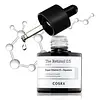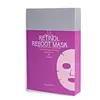What's inside
What's inside
 Key Ingredients
Key Ingredients

 Benefits
Benefits

 Concerns
Concerns

 Ingredients Side-by-side
Ingredients Side-by-side

Water
Skin ConditioningDipropylene Glycol
HumectantButylene Glycol
HumectantGlycerin
HumectantNiacinamide
SmoothingHydroxyacetophenone
AntioxidantCaprylyl Glycol
EmollientBetaine
HumectantGlyceryl Glucoside
HumectantCarbomer
Emulsion StabilisingArginine
Masking1,2-Hexanediol
Skin ConditioningAmmonium Acryloyldimethyltaurate/Vp Copolymer
Ethylhexylglycerin
Skin ConditioningSodium Hyaluronate
HumectantXanthan Gum
EmulsifyingAllantoin
Skin ConditioningDisodium EDTA
Retinol
Skin ConditioningRetinyl Acetate
Skin ConditioningBeta-Glucan
Skin ConditioningSclerotium Gum
Emulsion StabilisingFerulic Acid
AntimicrobialCaprylic/Capric Triglyceride
MaskingAcetyl Hydroxyproline
EmollientPolyglyceryl-10 Diisostearate
EmulsifyingHydrogenated Lecithin
EmulsifyingAstaxanthin
Skin ConditioningFullerenes
AntimicrobialPentylene Glycol
Skin ConditioningDipotassium Glycyrrhizate
HumectantGlycine Soja Oil
EmollientCalcium Pantothenate
Ascorbic Acid
AntioxidantPvp
Emulsion StabilisingTocopherol
AntioxidantLinoleic Acid
CleansingUbiquinone
AntioxidantBiotin
AntiseborrhoeicWater, Dipropylene Glycol, Butylene Glycol, Glycerin, Niacinamide, Hydroxyacetophenone, Caprylyl Glycol, Betaine, Glyceryl Glucoside, Carbomer, Arginine, 1,2-Hexanediol, Ammonium Acryloyldimethyltaurate/Vp Copolymer, Ethylhexylglycerin, Sodium Hyaluronate, Xanthan Gum, Allantoin, Disodium EDTA, Retinol, Retinyl Acetate, Beta-Glucan, Sclerotium Gum, Ferulic Acid, Caprylic/Capric Triglyceride, Acetyl Hydroxyproline, Polyglyceryl-10 Diisostearate, Hydrogenated Lecithin, Astaxanthin, Fullerenes, Pentylene Glycol, Dipotassium Glycyrrhizate, Glycine Soja Oil, Calcium Pantothenate, Ascorbic Acid, Pvp, Tocopherol, Linoleic Acid, Ubiquinone, Biotin
 Reviews
Reviews

Ingredients Explained
These ingredients are found in both products.
Ingredients higher up in an ingredient list are typically present in a larger amount.
This ingredient is an emollient, solvent, and texture enhancer. It is considered a skin-softener by helping the skin prevent moisture loss.
It helps thicken a product's formula and makes it easier to spread by dissolving clumping compounds.
Caprylic Triglyceride is made by combining glycerin with coconut oil, forming a clear liquid.
While there is an assumption Caprylic Triglyceride can clog pores due to it being derived from coconut oil, there is no research supporting this.
Learn more about Caprylic/Capric TriglycerideGlycine Soja Oil comes from the soybean. Glycine Soja is native to eastern Asia.
Soybean oil is an emollient. It is rich in antioxidants and fatty acids including palmitic, stearic, oleic, and linoleic acids.
As an emollient, the fatty acids in soybean oil helps keep your skin soft and hydrated. It does so by creating a film on top that traps moisture in.
Soybean oil is also rich in vitamin E, a potent antioxidant. Vitamin E is also anti-inflammatory and provides a soothing effect.
Studies show soy may help fade hyperpigmentation from UVB. It does so by disrupting the melanin process from UVB induced skin inflammation.
This ingredient may not be malassezia folliculitis, or fungal-acne, safe.
Soybeans are rich in proteins and are part of the legume family. Foods made with soybeans include tofu, soymilk, edamame, miso, and soy sauce.
Learn more about Glycine Soja OilRetinol is a gold-standard ingredient for anti-aging. It is a form of Vitamin A and belongs to the class of retinoids that also includes tretinoin.
Why is retinol famous?
It has the most scientific studies backing up its skin benefits out of all the non-prescription ingredients.
Retinol is proven to:
This is why retinol is effective at removing wrinkles, fading dark spots, treating acne, and reducing the appearance of pores.
Studies show retinol is less effective when exposed to UV. Be sure to look for appropriate packaging to keep your retinol potent (similar to Vitamin C).
Using retinol or any retinoids will increase sun-sensitivity in the first few months. Though studies show retinoids increase your skin's natural SPF with continuous use, it is best to always wear sunscreen and sun-protection.
We recommend speaking with a medical professional about using this ingredient during pregnancy.
Retinol may cause irritation in some people, so be sure to patch test. Experts recommend 'ramping up' retinol use: start using this ingredient once a week and work up to using it daily.
Read about Tretinoin
Learn more about RetinolTocopherol (also known as Vitamin E) is a common antioxidant used to help protect the skin from free-radicals and strengthen the skin barrier. It's also fat soluble - this means our skin is great at absorbing it.
Vitamin E also helps keep your natural skin lipids healthy. Your lipid skin barrier naturally consists of lipids, ceramides, and fatty acids. Vitamin E offers extra protection for your skin’s lipid barrier, keeping your skin healthy and nourished.
Another benefit is a bit of UV protection. Vitamin E helps reduce the damage caused by UVB rays. (It should not replace your sunscreen). Combining it with Vitamin C can decrease sunburned cells and hyperpigmentation after UV exposure.
You might have noticed Vitamin E + C often paired together. This is because it is great at stabilizing Vitamin C. Using the two together helps increase the effectiveness of both ingredients.
There are often claims that Vitamin E can reduce/prevent scarring, but these claims haven't been confirmed by scientific research.
Learn more about Tocopherol